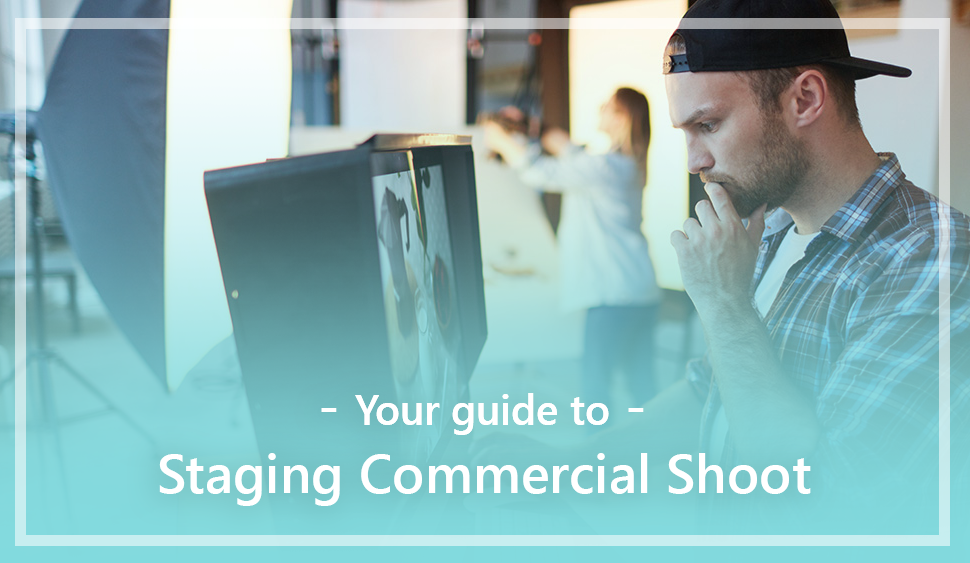Some of the most memorable TV commercials in existence utilize best practices in staging that meld seamlessly with impeccable writing and acting. Since consumers are exposed to approximately 30 ads an hour just on TV, creating a cohesive atmosphere between the actors and background is critical in creating memorable ads that inspire audiences to act.
Working as a Production Designer requires:
- Wide variety of knowledge in fine art, interior design, and even performance art.
- Attention to detail combined with the ability to create appealing spaces from the ground up
At the same time, set designers shouldn’t assume they need to always recreate the wheel for every project and should explore every possible available option.
Many commercial projects entail creating backgrounds for normal living situations, and this can surprisingly be quite challenging. Design can take a wide variety of twists and turns when it comes to shooting commercials, and there may be an instance where a set may have to look as if it had been lived in for some time. Creating instant wear and tear to furniture is easier said than done, but thrifting and finding the right look for used furniture can help to create this particular atmosphere if needed.
No matter what a commercial shoot entails, the best Production Designers in the industry rely on their knowledge, instincts, and are not afraid to experiment with new ideas.
Iterating on designs may sometimes be necessary but trying new pieces of furniture, adding or taking away details, or moving the furniture around in the space you’ll be shooting in are all part of the process of creating vibrant sets for commercial shoots.
Setting the Stage for Staging
Whether you prefer the term set dressing, staging, or Production Designer, this critical position requires vigilant attention to detail. Tackling a blank space and creating the artistic vision for your commercial shoot can be the most difficult part of a project as a whole. Production designers have to know the ins and outs of both the brand and the script before beginning to identify furniture, and layout the interior design. And depending on the size of the project, staging may also require curating items and managing a budget.
When assessing the script, extracting visual cues and noting them during the analysis portion of the project will create a solid foundation for dynamic set design. Listed below are a few tips that Production Designers should keep in mind when reviewing scripts for commercial shoots.
Note scene aesthetics
Note any obvious mentions of particular pieces of furniture or scene aesthetics. If the character is sitting in the scene, then that should be noted because you’ll most definitely need a seating area of some sort. If the setting is in a living room, then creating an entire living room scene that supports the storyline and character will be necessary.
Consider brand colors
Requesting the brand’s color palette is also an excellent place to start. Working this into the set design will help to reinforce the brand’s visual cues throughout the space. This could be as simple as matching the brand colors with background colors for curtains, pillows, blankets, or even smaller items like laptops or notebooks.
Make design cohesive with the character
If you are shooting an alternate reality, fantasy, sci-fi, or period piece in a single space, then thinking about interior design and furniture that not only represents the time and place but also is cohesive with the character and scene is necessa Mark Digby who is the Production Designer for the series “Devs” on Hulu, used a vintage setting to portray elements of the show’s fictional futuristic quantum computing company offices. This goes to show that when you are tackling rooms and single spaces, even with a futuristic twist, the design can still have a classical structure with a few modern twists.
Optimizing Small Spaces On Set
Working with small spaces can be challenging, especially when you have a limited space to tell a very specific story. The first thing to keep in mind when designing a smaller space is to maximize every piece that goes into that area. Every item should have a meaning and be intentionally placed where it is because there will be no room for fluff pieces. Depending on the scene and storyline, bold and striking accessories will bring out the best in the room but could also be distracting. If you have to tone it down, doing a deep dive into the character and placing more subtle pieces in the room that reflects the character and brand will add profundity to the background that won’t overwhelm the audience.
Production Designers must ensure that they give small spaces as much depth as they can. Different textures add richness to backgrounds, and this doesn’t only have to be done with additional materials. Adding furniture with textured fabrics and Roman shades underneath curtains are ways to pull small spaces to the forefront without taking up extra space on the floor. Mixing together multiple elements such as wood, glass, textured fabrics, and metal objects also helps observers find hidden gems and stay engaged with small spaces.
Interior Design Looks That Flatter Commercial Sets
Audiences everywhere love to be inspired by interior designs that they see in commercials, and pieces that make people oooh and ahhh always go over well. Picking out innovative furniture that pushes the limits of design and meshes with the set, but are also more distinct, give a crisp look to commercial backgrounds. Large furniture can dominate scenes, and if you don’t have distance on your side or if the furniture needs to blend into the background, light colors and less bulk in furniture selections is a better path.
No matter what furniture options are chosen, balancing your space is critical.
This should happen once furniture is selected and physically present in the actual area that you are going to film in. As necessary planning is, sometimes furniture can look different on camera, or you may realize that your large to small furniture ratio might be off. Adding or taking away might be necessary once you look at the set design through the camera lens, and make sure to plan for the number of actors that will be present. Lighting is the last piece, and working with whoever is in charge of your on-set lighting will definitely bring the best out of your set design.
Pinpointing Visual Brand Cues
Nielson’s yearly branding best practices guide recommends that brands leverage creative visual artifacts that reinforce brand stories. Production Designers can strengthen this fundamental part of branding by adding in physical symbols of the company or organization’s brand and mission. Some of the most iconic brands use color and materials to represent their mission. Paying careful attention to your set design to make sure that it honors the brand’s mission that you are representing is essential.
For example, the growing collective of beauty brands that are going green and are taking a stand against animal testing is increasing every day. Using even faux animal prints, leather, or fur as part of your set design may not be cleared by their creative department. In a case such as this, ensuring that any furniture and materials that are chosen abide by the organization’s mission will ensure the success of the finished product.
The Target Corporation successfully utilizes its branding colors in a remarkable way in all of their commercials. Red and white walls, doors, fixtures, furniture, products, and sometimes food reinforce the peppy brand’s bright color palette and emulate an inviting and fun environment for shopping for everyday goods. Target’s epic colorful backgrounds are action-packed and move quickly from scene to scene, showing well-designed sets that offer multiple branding points that amaze audiences.
Conclusion
Commercials have made their mark on the world since television programming came to fruition and the golden standard in the commercial space is the highly anticipated Superbowl commercial. One of the most impactful Superbowl commercials that will forever be remembered is the 2015 PSA that supported the NO MORE movement used to create awareness about domestic violence. The commercial in itself is fairly simple in terms of the set design.
- The scene opens on a plain white fireplace mantel in a family home that's pristine and perfectly set with just a single candlestick and other well-placed decorations. As the commercial continues, a 911 call starts to play as the scene moves from the fireplace to the living room, and more of the house comes into view.
- The decor is a mix of modern and vintage pieces, and the white and pastel colors of the fabric contrast sharply in a very intentional way with the dark lighting. Small details like an unmade bed with no headboard and two basic pillows, and a ruffled rug come into view before the camera spans across the second candlestick laying in the middle of the living room floor, broken family photos, and close shots of holes in the walls.
- The powerful imagery in this striking commercial was shot without actors and in only a few places in a house, but its careful interior design supported the powerful message of how to call 911 even if a domestic attacker is in the room with you. This commercial is the perfect example of just how Production Designers can work collaboratively with other members of their production team to make sure that the commercial shoot's textures, colors, furniture, accessories, materials, props, and lighting fall under one unified artistic vision.





